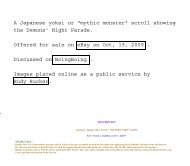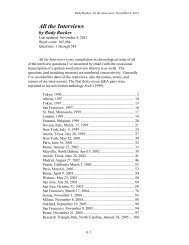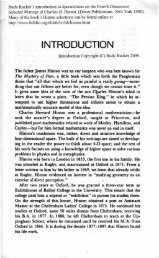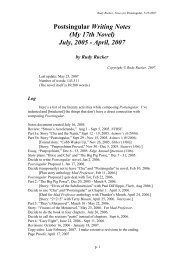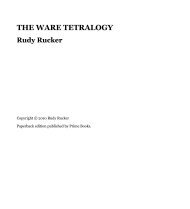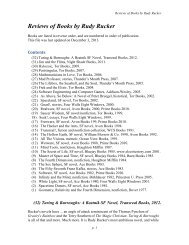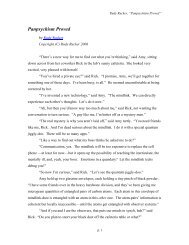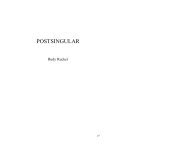Notes for the Lifebox, the Seashell, and the Soul - Rudy Rucker
Notes for the Lifebox, the Seashell, and the Soul - Rudy Rucker
Notes for the Lifebox, the Seashell, and the Soul - Rudy Rucker
You also want an ePaper? Increase the reach of your titles
YUMPU automatically turns print PDFs into web optimized ePapers that Google loves.
<strong>Notes</strong> <strong>for</strong> The <strong>Lifebox</strong>, <strong>the</strong> <strong>Seashell</strong>, <strong>and</strong> <strong>the</strong> <strong>Soul</strong>, by <strong>Rudy</strong> <strong>Rucker</strong><br />
2350 Programmable clones It becomes possible to grow a clone of yourself in a tank<br />
<strong>and</strong> program its brain with <strong>the</strong> contents of your lifebox<br />
file, creating a person very much like yourself.<br />
3001 The alla The age of direct matter control arrives <strong>and</strong> we can<br />
change anything into anything. Matter is fully<br />
programmable.<br />
3002 Space migration People use allas to live in asteroids<br />
3003 3ox A new technology <strong>for</strong> identically copying an existing<br />
objects, including living beings<br />
3150 Ooies Uvvies become internal organs, so that people are<br />
constantly in contact. Society truly becomes a hive.<br />
3400 Colony people Some individuals 3ox or clone hundreds of copies of<br />
<strong>the</strong>mselves, with <strong>the</strong> copies connected via ooie.<br />
3400 Spacebug people Still more advanced bioengineering allows people to live<br />
in <strong>the</strong> hard vacuum of outer space.<br />
3666 Teleportation Insight into fundamental physics gives people <strong>the</strong> ability<br />
to jump to arbitrarily distant space locations.<br />
4050 People free to move in<br />
higher dimensions<br />
Travel to <strong>the</strong> o<strong>the</strong>r worlds beyond our space <strong>and</strong> time.<br />
Stepping Through an Argument <strong>for</strong> <strong>the</strong> Universal Unpredictability Lemma<br />
Let’s consider <strong>the</strong> universally computing CA Rule 110 <strong>and</strong> see what happens if we try<br />
to carry out Wolfram’s argument sketched on NKS, p. 742, that a universal computation is<br />
“computationally irreducible.”<br />
Specifically, let’s look at a computation C110 such that if rowcount is an integer<br />
measuring <strong>the</strong> number of number of rows to be computed <strong>and</strong> if input is an integer that codes<br />
up a start pattern <strong>the</strong>n C110(rowcount, input) = output, means that output is an integer coding<br />
up <strong>the</strong> rowcount th row of a Rule 110 computation starting with <strong>the</strong> pattern coded by input.<br />
Normally, computing C110(rowcount, input) = output takes rowcount*input + n 2<br />
individual cell-update steps or, if you prefer, rowcount row-updates.<br />
Now suppose we have a prediction algorithm called Predictor such that<br />
Predictor(rowcount, input) = output maps rowcount-input pairs into output rows just like<br />
C110 does. And suppose that Predictor computes this in some very small number of<br />
computational steps PredictorRuntime(rowcount, input). We might imagine that <strong>for</strong><br />
sufficiently large rowcount <strong>and</strong> input, this runtime number might be on <strong>the</strong> order of <strong>the</strong><br />
logarithms of <strong>the</strong> second two arguments, that is, we might expect that<br />
PredictorRuntime(rowcount, input) º log(rowcount)+log(input)<br />
Wolfram’s argument suggests that we now use <strong>the</strong> universality of Rule 110 to let it<br />
simulate <strong>the</strong> computation Predictor(rowcount, input). Simulating Predictor means that we<br />
have a string prog coding up <strong>the</strong> program of Predictor <strong>and</strong> that we can combine prog with a<br />
desired rowcount count <strong>and</strong> an arbitrary input to make a new argument called, say, progrowcount-input.<br />
We feed prog-rowcount-input into C110, <strong>and</strong> by computing some as yet<br />
unknown number of rows simulationrowcount, <strong>the</strong> computation of<br />
C110(simulationrowcount, prog-rowcount-input) will emulate Predictor(rowcount, input) by<br />
generating output, that is by producing <strong>the</strong> rowcount th row of Rule 110 starting with input.<br />
p. 96




